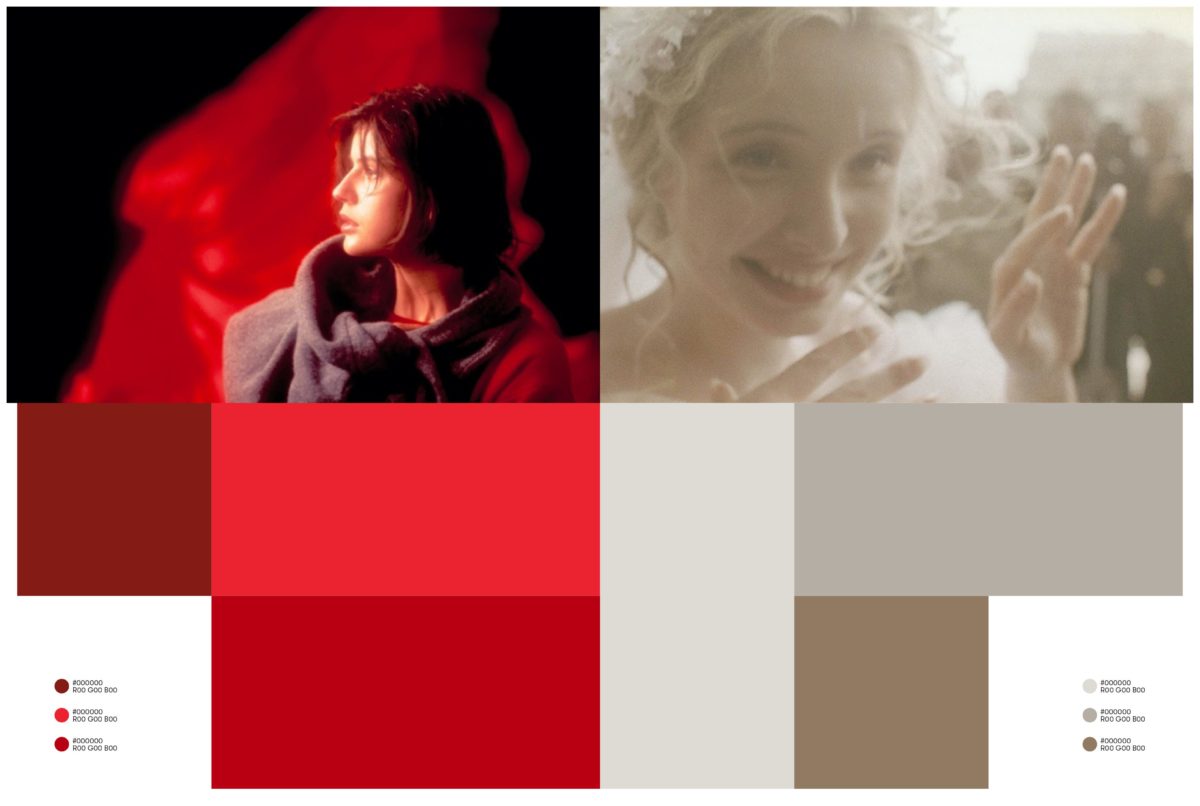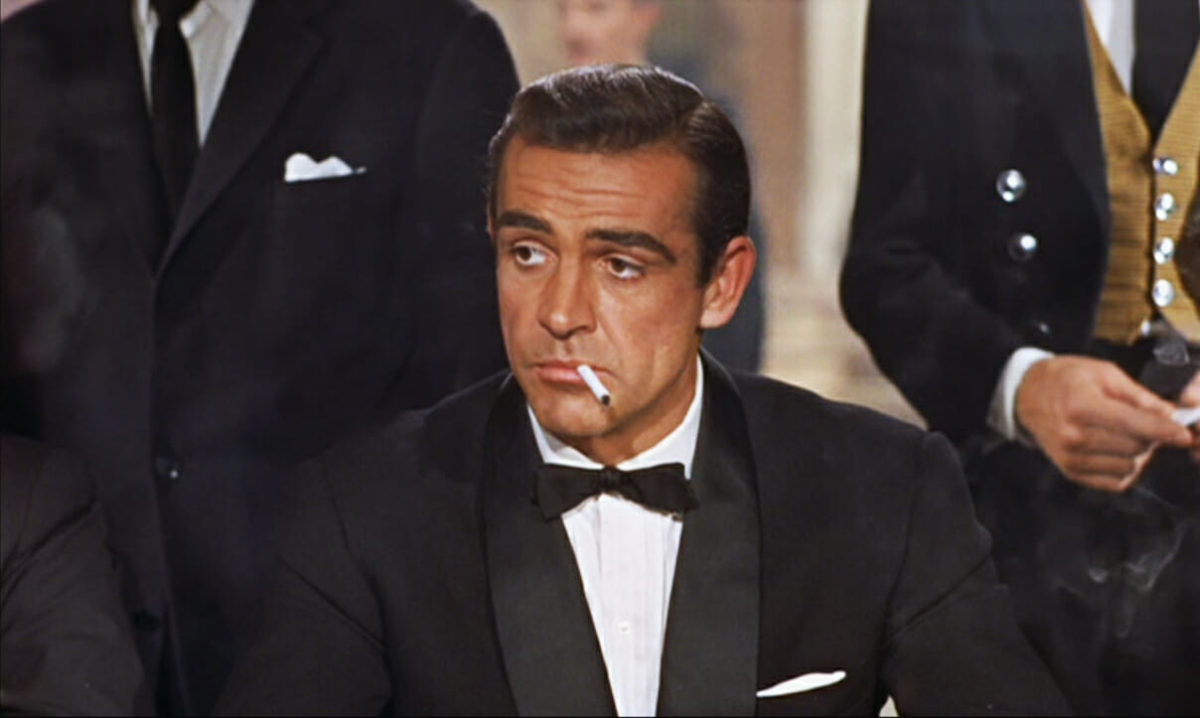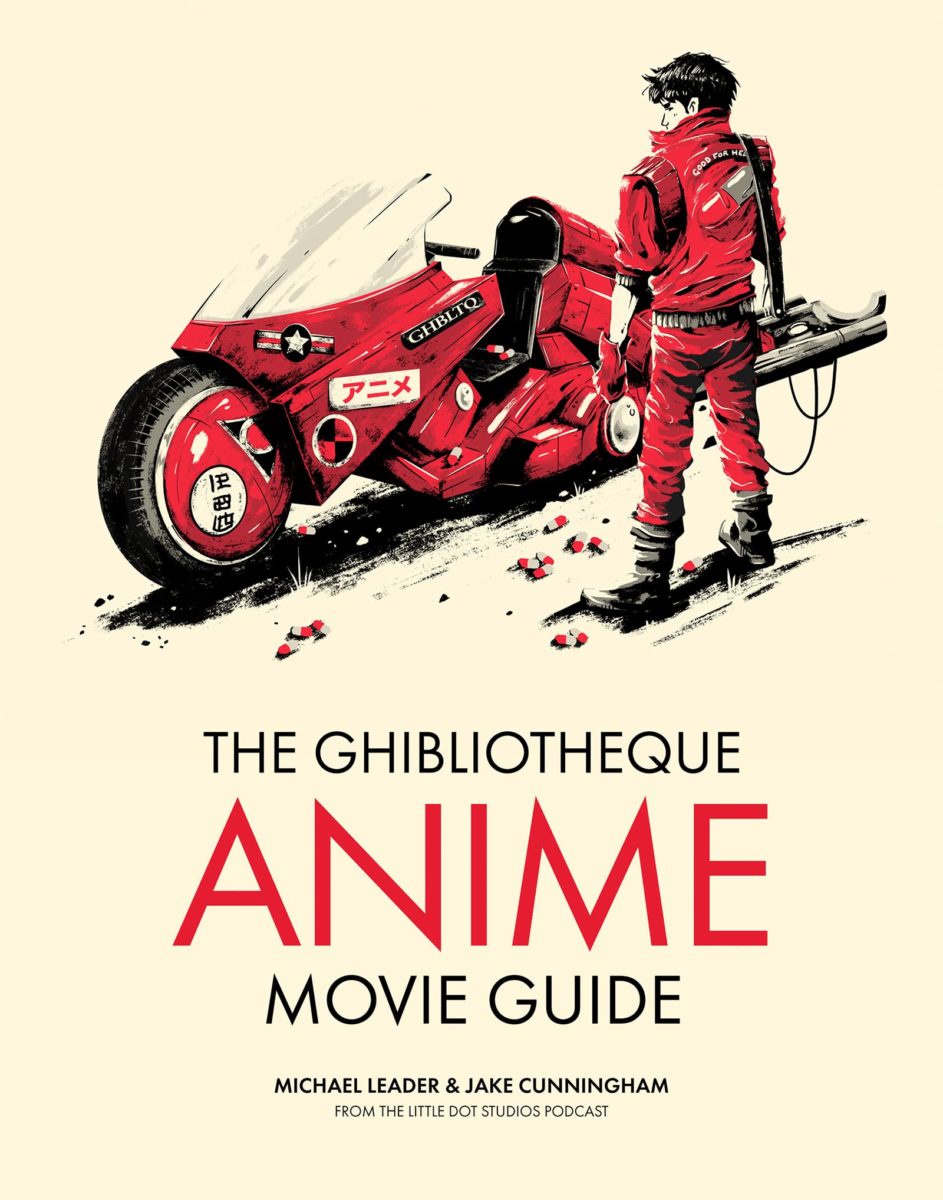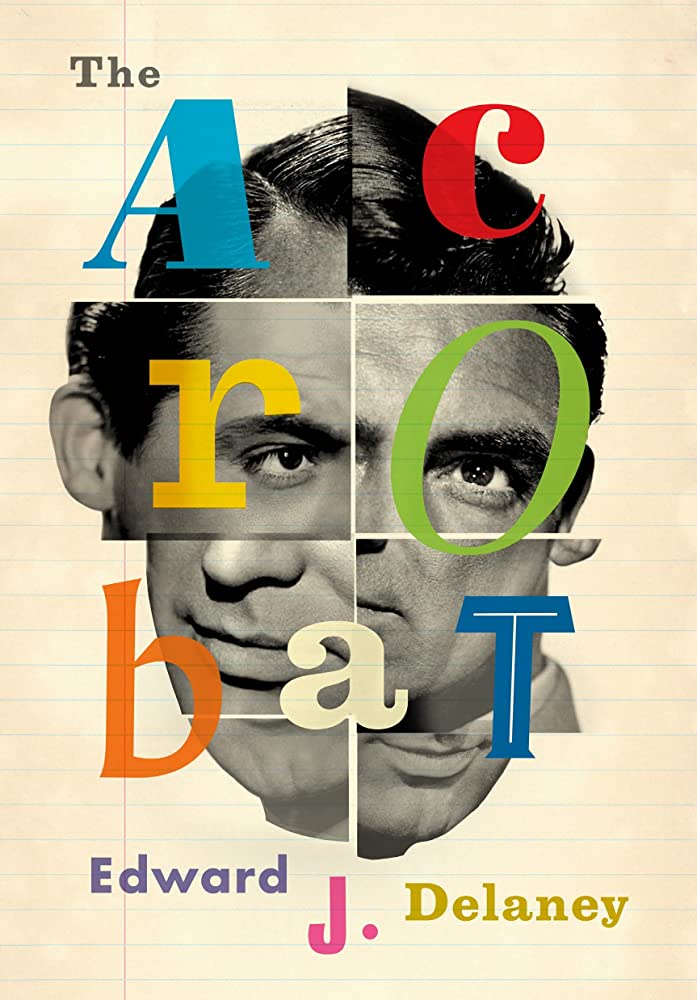For our latest dive into recent books on or related to cinema, we’re spending time with some icons––fictional (James Bond) and non (Sofia Coppola, Sean Connery, Haruki Murakami, the Beatles). Let’s start with 50 color palettes and one beautifully unique new text.
Colors of Film: The Story of Cinema in 50 Palettes by Charles Bramesco (Frances Lincoln)

Colors of Film is an engrossing study of how filmmakers utilize color in complex, ingenious, emotionally impactful ways. Some of these examples (e.g. the red jacket in Schindler’s List) have inspired much discourse. What makes this book––by the always-entertaining and -intelligent critic Charles Bramesco––so special is its focus on less-obvious films. A noteworthy case: Hype Williams’ Belly and its “flights of stylistic fancy.” During its hyper-stylized opening, as gangsters Buns and Sin “prowl through the dance floor, ceiling-mounted blacklights make the men look extraterrestrial, their eyeballs glowstick-turquoise against deeper blue skin.” Other entries focus on everything from Méliès and Sirk to Fassbinder and McQueen. Bramesco’s writing is enthusiastic and wise; his book is a genuine delight.
Love and Let Die: James Bond, the Beatles, and the British Psyche by John Higgs (Pegasus Books) and The Cinematic Connery: The Films of Sir Sean Connery by A.J. Black (Polaris Publishing)

James Bond never leaves the news cycle for too long, and lately Ian Fleming’s 007 has made headlines with casting rumors and remastered versions of the N64 classic Goldeneye 007. Two new books explore the legacy of the character and the series in unique ways. Love and Let Die is a fabulously entertaining, hugely insightful exploration of the many connections between Bond and the Beatles. Consider this startling fact revealed by author John Higgs: “Friday, 5 October 1962, saw the release of ‘Love Me Do,’ the first record by the Beatles, and Dr. No, the first James Bond film.” Two “monsters in the cultural ecosystem,” as Higgs puts it, taking their first steps on the same day is downright incredible. “Most countries can only dream of a cultural export becoming a worldwide phenomenon on this scale,” Higgs writes. “For Britain to produce two on the same windy October afternoon was, by anyone’s standards, unusual.” The book covers both the entirety of the Bond series and the life and careers of the Fab Four (together and solo). As expected, Sean Connery plays a large role. And in The Cinematic Connery the late icon takes center stage. A.J. Black provides a tremendous overview of his career, including deep dives into some of its oddities; I was unfamiliar with Fred Zinneman’s Swiss Alps-set, incest-themed (!) Five Days One Summer. Taken together, these new works from Black and Higgs demonstrate why Connery––and his most famous character––still loom so large in cinema.
On the Dance Floor: Spinning Out on Screen edited by Claire Marie Healy (A24)
Every few months or so A24 drops a killer new book. Its latest, On the Dance Floor: Spinning Out on Screen, is their biggest, boldest, and (literally) heaviest yet. There are stills from a dizzying variety of films (among them Lovers Rock, The Last Days of Disco, and Happy Together), “Dance Floor Dispatches” from Charli XCX and others, and a forward by Cher. “I can’t remember a time when I didn’t sing and dance,” she writes. “Those are my first memories.” If paging through On the Dance Floor doesn’t actually make you get up and move, it should at least inspire readers to press play on some of the cinematic moments excerpted here––and maybe to rediscover 1990’s Mermaids.
The Ghibliotheque Anime Movie Guide: The Essential Guide to Japanese Animated Cinema by Jake Cunningham and Michael Leader (Welbeck)

Ghibliotheque podcast co-hosts Michael Leader and Jake Cunningham offer a nice primer for anime newcomers with The Ghibliotheque Anime Movie Guide. Even veteran fans should find the book of interest. The follow-up to 2021’s Ghibliotheque: Unofficial Guide to the Movies of Studio Ghibli is, according to its authors, “a broad selection that highlights many of the exciting genres, filmmakers, trends, and themes that you can find when dipping your toe into Japanese animation.” Many are well-known beyond the realm of anime die-hards––like Akira, Belladonna of Sadness, Ghost in the Shell, Millennium Actress, and Your Name. The Essential Guide goes much deeper, though, covering 25 other groundbreaking gems.
Sofia Coppola, Louis Malle, and Joyce Chopra in their own words
Three recent releases––two books of interviews and one memoir––allow readers to hear the first-hand points-of-view of three significant filmmakers. Sofia Coppola: Interviews edited by Amy N. Monaghan (University Press of Mississippi) features chats that are as diverse and enjoyable as Coppola’s career. It opens with two surprises: a 1977 conversation between five-year-old Sofia and her father, Francis Ford Coppola, followed by a wacky look at Hi-Octane, her 1995 Comedy Central series. It is always a treat to hear Coppola discuss The Virgin Suicides and her more well-known works, but particularly fruitful are her thoughts on The Beguiled; Coppola makes fascinating connections between the Colin Farrell-Kirsten Dunst drama and her own work, especially Suicides, as well as Peter Weir’s Picnic at Hanging Rock.
Interviews with the late director of Elevator to the Gallows, Atlantic City, My Dinner With Andre, and Au revoir les enfants make up Louis Malle: Interviews edited by Christopher Beach (University Press of Mississippi). The conversations with Malle date from 1960 to 1994, shortly before his death from lymphoma. Especially interesting are his thoughts on the controversies surrounding Brooke Shields-starrer Pretty Baby and the disastrous production of 1984’s Crackers. Throughout Malle speaks with candor and wisdom.
The same can be said of Joyce Chopra and her memoir Lady Director: Adventures in Hollywood, Television and Beyond (City Lights). The underrated filmmaker is best known for 1985’s powerful Joyce Carol Oates adaptation Smooth Talk. In Lady Director she beautifully discusses the struggles of being a trailblazer in a male-dominated field. Some memories are painful, like her encounters with Harvey Weinstein during the editing of The Lemon Sisters. (“I was alive but had little desire to get behind a camera ever again.”) Ultimately, though, Chopra’s story is one of perseverance and triumph.
Frank Herbert’s Dune: The Graphic Novel, Book 2: Muad’Dib adapted by Brian Herbert and Kevin J. Anderson, illustrated by Raúl Allén and Patricia Martín (Abrams ComicArts)

The second book in Abrams ComicArts’ three-part series covering Frank Herbert’s sci-fi classic, Dune: The Graphic Novel, Book 2 is a fine continuation of the story of Paul Atreides on the planet Arrakis. It picks up with Paul and his mother, the Lady Jessica, stranded on their own and leads to their encounters with the Fremen. Like book one, this is a tightly adapted (by Frank Herbert’s son, Brian, and Kevin J. Anderson), lovingly illustrated (by Raúl Allén and Patricia Martín) way to satisfy your Dune cravings until Dune: Part Two hits in November.
New music books:
Pink Floyd and the Dark Side of the Moon: 50 Years by Martin Popoff (Motorbooks) is a gloriously pretty hardcover celebration of the band’s 1973 landmark. It also provides a fairly exhaustive look at the band’s pre-Dark Side career and the tours that supported the album. Especially notable are the details of the cover art designed by Hipgnosis. (The cover almost ended up being a depiction of Marvel’s Silver Surfer.) Also written by Popoff is AC/DC at 50 (Motorbooks; released on March 28), another hardcover, photo-packed entry. The history of the Australian rockers is of course filled with tragedy and triumph, and Popoff covers it all in splendid detail. Especially enthralling is the tale of Axl Rose’s brief stint as frontman in 2016.
Stereogum readers have likely enjoyed Tom Breihan’s “The Number Ones” column, a consideration of Billboard Hot 100 chart-toppers. The Number Ones: Twenty Chart-Topping Hits That Reveal the History of Pop Music (Hachette Books) expands on the column’s brilliance with a clever run through 20 historically relevant smash hits––from Chubby Checker to BTS. Far more somber (but very, very moving) is George Michael: A Life by James Gavin (Abrams Press). The life of the singer born Georgios Panayiotou has long fascinated the world. The highs––success with Wham, mammoth solo hits like “Faith” and “Freedom”––were very high. Still, Gavin shows an artist who was constantly conflicted. The second half of the book is almost relentlessly sad: lawsuits, high-profile arrests, personal calamities, and an artistic output that simply could not equal what he’d done previously. But the reader finishes A Life with a healthy respect for Michael and all that he accomplished. Kudos to Gavin for crafting an extremely compelling biography that feels honest and respectful.
And Conform to Deform: The Weird & Wonderful World Of Some Bizzare by Wesley Doyle (Jawbone Press) provides an oral history of the U.K. independent record label known for bands like Soft Cell and The The. One of the most captivating chapters outlines the creation and release of Some Bizzare Album, a compilation of unsigned bands, among them an unknown synth-pop band named Depeche Mode. The book is highlighted by a tasty mix of wild personalities, including label founder Stevo and Soft Cell frontman Marc Almond. “It was a strange symbiosis,” Almond states. “I often think that if I was Stevo’s Elvis, then he was definitely my Colonel Tom Parker. I’m not sure if that’s a good thing or not.”
New novels (and one look at the novelist’s life):
Before running through some noteworthy new novels, let us start with a unique new non-fiction book from one of the world’s greatest writers. Novelist as a Vocation by Haruki Murakami (Knopf) is an endearing exploration of what the novel is (and is not) from the author of Norwegian Wood, Kafka on the Shore, and 1Q84. It also succeeds as something of a memoir, with Murakami discussing his dislike of school (“thinking about [memories of school] makes my neck throb and ache”) and how hearing the Beatles made him feel “[l]iberated from the constraints of reality.” A highly engaging, deeply personal work for those who adore Murakami’s novels.
Also engaging, but for very different reasons, is Anon Pls. by Deuxmoi (William Morrow). Yes, that is the Deuxmoi––or should I say, @Deuxmoi––creator of the celebrity gossip Instagram account. Anon’s juicy story of an assistant-turned-gossip blogger feels ripped from Instagram in the best sense. I imagine Bret Easton Ellis has read his fair share of Deuxmoi. But the American Psycho author’s latest novel, The Shards (Knopf), looks to the past. Los Angeles in the 1980s is the setting for a riveting serial killer thriller that plays with fact (the main character is one Bret Easton Ellis) and fiction.

How to Sell a Haunted House by Grady Hendrix (Berkley) is an even fiercer comic-horror firecracker than Hendrix’s previous novel, The Final Girl Support Group. This clever take on the haunted house genre is destined for a film or series adaptation. I hope the same will be true of The Acrobat by Edward J. Delaney (Turtle Point Press), but that could be tricky. Why? Because they’ll have to find the right actor to play a convincing Cary Grant. It’s an inventive fictional imagining of Grant as a 55-year-old undergoing LSD treatment.
Star Wars fans will enjoy two recent High Republic series novels, Convergence by Zoraida Córdova and The Battle of Jedha by George Mann. The latter is the script to a well-received audio drama.
And the filmgoers who made Tom Hanks vehicle A Man Called Otto a winter hit should pick up The Winners by Fredrik Backman (Atria Books). The Swedish author, whose A Man Called Ove was the basis for that film, has set two other books in a hockey-loving community known as Beartown. Winners, the third in his trilogy, is long, ambitious, moving, and quite funny.
Recently adapted fiction and non-fiction:
In addition to the novels recommended above, it is worth checking out some books with adaptations on screens large and small. The aforementioned Haruki Murakami’s Blind Willow, Sleeping Woman, a short story collection published in 2006, (based on the story collection by Haruki Murakami), is the basis for a French-language animated film of the same name; it adapts six of the book’s stories. Airing on Hulu in April (and starring Kathryn Hahn) is a series based on Cheryl Strayed’s Tiny Beautiful Things: Advice from Dear Sugar. Meanwhile, author Richard Russo has been on a spotty run since the release of his masterful Empire Falls in 2001. But there is no denying the comic brilliance of his takedown of the world of academia, Straight Man. An AMC series based on the book, starring Bob Odenkirk, will begin airing this month with the title Lucky Hank.
The acclaimed documentary Turn Every Page — The Adventures of Robert Caro and Robert Gottlieb may inspire new interest in the work of Pulitzer Prize-winning author Caro and editor Gottlieb. The former’s mighty Robert Moses bio, The Power Broker, is always worth revisiting, as is his 2019 memoir, Working. Similarly, Neil Jordan’s Marlowe, featuring Liam Neeson as Raymond Chandler’s iconic character, should lead viewers back to classics like The Lady in the Lake, The Little Sister, The Long Goodbye, and Playback; many are collected into larger volumes of the author’s work. And Frances O’Connor’s Emily, a stunning Emily Brontë biopic, is sure to cause many to pick up Wuthering Heights once more. (The film, which I reviewed at the 2022 Toronto International Film Festival, is heartbreakingly lovely.)
Lastly: before Christopher Nolan’s Oppenheimer detonates cinemas, there is time to read American Prometheus by Kai Bird and Martin J. Sherwin (Vintage). Better get started, though––this Pulitzer Prize-winning biography of J. Robert Oppenheimer is more than 700 pages long.
